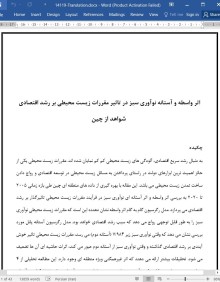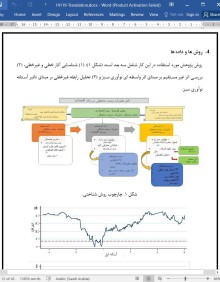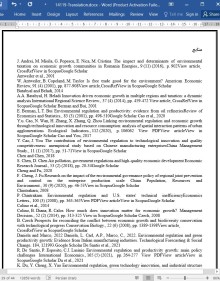
دانلود مقاله اثر واسطه و آستانه نوآوری سبز در تاثیر مقررات زیست محیطی بر رشد اقتصادی
چکیده
به دنبال رشد سریع اقتصادی، آلودگی های زیست محیطی کم کم نمایان شده اند. مقررات زیست محیطی یکی از حائز اهمیت ترین ابزارهای دولت در راستای پرداختن به مسائل زیست محیطی در توسعه اقتصادی و رواج دادن ساخت تمدن زیست محیطی می باشد. این مقاله با بهره گیری از داده های منطقه ای چین طی بازه زمانی 2005 تا 2020 به بررسی اثر واسطه و اثر آستانه ای نوآوری سبز در فرآیند مقررات زیست محیطی تاثیرگذار بر رشد اقتصادی می پردازد. مدل رگرسیون گام به گام اثر واسطه نشان دهنده این است که مقررات زیست محیطی نوآوری سبز را به طور قابل توجهی رواج می دهد که سبب رشد اقتصادی خواهد بود. مدل رگرسیون آستانه پانل مورد بررسی نشان می دهد که وقتی نوآوری سبز زیر 984/7 (آستانه دوم) می رسد، مقررات زیست محیطی تاثیر خوش آیندی بر رشد اقتصادی گذاشته و وقتی نوآوری سبز از آستانه دوم عبور می کند، اثرات حاشیه ای آن ها تضعیف می شود. تحقیقات بیشتر ارائه می دهند که اثر غیرهمگنی ویژه منطقه ای وجود دارد. این مطالعه تحلیلی از 4 منطقه چین می باشد. هنگامی که نوآوری سبز از حد معینی فراتر میرود (آستانه شرقی 4٫382 است، آستانه مرکزی 6٫553، آستانه غربی 5٫037، آستانه شمال شرقی 5٫347 است)، اثر حاشیه ای هر منطقه را کاهش میدهد. نتایج این پژوهش می تواند بعنوان مرجعی برای دولت باشد که سیاست های عاقلانه ای را به جهت برپایی توازن اقتصادی و زیست محیطی تدوین نماید.
1. مقدمه
غالبا رشد اقتصادی همراه با مشکلات آلودگی محیط زیست می باشد و حفاظت از محیط زیست در عمده توجهات قرار گرفته است. اقتصاد رو به رشد چین بسیار وابسته به مدل صنعتی سنتی (وانگ و وانگ، 2011) می باشد. آلودگی شدید زیست محیطی بازتابی اجتناب ناپذیر از توسعه اقتصادی وسیع بوده و آسیب های آن به جامعه کم کم مشخص میشود. دیگر قادر نیستیم برای توسعه اقتصادی بر مصرف بیش از حد محیط زیست تکیه کنیم و مشکلات زیست محیطی چین به یکی از عامل های چاره ساز محدودکننده توسعه اقتصادی مبدل شده است. این در حالتی که ما مشوق رشد سریع اقتصاد هستیم، ایجاب می شود که روی محافظت از محیط زیست هم متمرکز باشیم. این روزها، میان نیاز متزاید مردم به زندگی بهتر و توسعه نابرابر و نامتوازن، تضادی وجود دارد، و محیطی زیبا بنای یک زندگی خوشایند برای عموم مردم می باشد. هجدهمین کنگره ملی مردم حزب کمونیست چین سفارش کرد که ساخت تمدن اکولوژیکی باید در موقعیت چشمگیرتری قرار گیرد و ایده ی بزرگ «آب های زلال و کوه های سرسبز سرمایه های ارزشمندی هستند» را پیش کشید. به طور رسمی اقتصاد چین وارد رده ی توسعه سبز شده است.
تبلیغات چین به جهت حفاظت از محیط زیست دیر هنگام آغاز میشود، هوشیاری مردم در مورد محیط زیست کافی نیست، شرکت ها نوآوری عمل در راستای محافظت از محیط زیست را در کانون تولیدات شرکت ها نگذاشته اند، که دولت را ملزم به فراگیری مقررات زیست محیطی برای محدود کردن می کند. بسیاری از مقررات و قوانین مرتبط با حفاظت از محیط زیست را دولت در طی سال های اخیر گردآوری کرده است. بعنوان مثال، قانون حفاظت از محیط زیست جمهوری خلق چین در سال 2014 اصلاح گردید، در سال 2016 قانون مالیات حفاظت از محیط زیست مصوب شد، قانون حفاظت از رودخانه یانگ تسه و قانون مالیات بر منابع در سال 2020 مصوب شدند، دولت عزم خود را برای مدیریت محیط زیست با اقدامات عملی ابراز می کند. در سال 2021، «هدف 3060» در گزارش کار دولت پیشنهاد شد، به این امید که در اوایل تاریخ به «اوج کربن» و «حنثی سازی کربن» برسد. دولت چین همواره حفاظت از محیط زیست را توان می بخشد، در تلاش است تا کیفیت محیط زیست را بهبود بخشد، امیدوار به این که ترفیع و تبدیل ساختار صنعتی را ارتقا دهد، حالت سنتی رشد اقتصادی را تغییر داده و از طریق حکومت های زیست محیطی توسعه اقتصادی بهتر و سریع تری را ترویج دهد.
7. نتیجه گیری و پیامدها
این مطالعه به بررسی و تبیین نقش نوآوری سبز در تاثیر مقررات زیست محیطی بر رشد اقتصادی می پردازد. طبق داده های پانل استانی چین از 2005 تا 2020، مدل رگرسیون گام به گام را به منظور واکاوی مکانیزم های مقررات زیست محیطی هدایت رشد اقتصادی بکار گرفته و به منظور تحلیل تاثیر آستانه نوآوری سبز مدل رگرسیون آستانه پانل را استفاده می نمایم.
یافته ها بیان می کند مقررات زیست محیطی، رشد اقتصادی را به طور مؤثر پیش می برد. واکاوی سازوکارها نشان می دهد که تاثیر گرفته از نقش واسطه ای نوآوری سبز قرار دارند، عملکرد ویژه به شرح زیر است: مقررات زیست محیطی قادرند نوآوری سبز شرکت ها را فعالانه تحریک و با مجبور کردن شرکت ها به اجرای نوآوری سبز رشد اقتصادی را تقویت نمایند. در دوره ای که اقتصاد چین با کیفیت بالا توسعه یافته است، مقررات محیط زیست مجموعا در سطح منطقه ای «جبران سازی نوآورانه» می یابد که این امر با فرضیه پورتر همخوانی دارد.
همچنین، اثر غیرخطی مقررات زیست محیطی بر رشد اقتصادی، به شرط اثر آستانه ای نوآوری سبز با تقلیل تاثیرات حاشیه ای می باشد. دو آستانه نوآوری سبز هست. یکی زمانی که زیر آستانه اول و یکی بین آستانه دو قرار بگیرد، مقررات زیست محیطی بر روی رشد اقتصادی اثری مثبت می گذارد. ولیکن هنگامی که از آستانه دوم رد شود (به سطوح بالاتر برود)، مقررات زیست محیطی بر رشد اقتصادی اثر منفی می گذارد. البته، فکر نمی کنم آستانه نوآوری سبز بالا باشد، زیر حد متوسط ملی است.
سعی بر این بود مکانیزم این سه مجموعه را از مناطق مختلف مورد بررسی قرار دهم. نتایج آنالیز ناهمگونی بیانگر این است که آستانه نوآوری سبز در ناحیه مرکزی بیشتر از میانگین کل جمعیت کشور بوده و این در حالی است که آستانه در چین شرقی دارای خداقل مقدار است. تاثیرات حاشیه ای مناطق مرکزی و شرقی کاهش می یابد، اما هر دو مثبت هستند. با مقررات زیست محیطی افزایش تعداد نوآوریهای سبز، هنوز به رشد اقتصادی کمک میکند، اما سرعت افزایش کاهش پیدا می کند. در مناطق غربی و شمال شرقی که آستانه نوآوری سبز در آنها در پی هم به 037/5 و 347/5 نائل می گردد، امکانش وجود دارد که مقررات زیست محیطی رشد اقتصادی را مهار سازد. تحقیق پیش رو نشان می دهد که از نوآوری سبز در روند مقررات زیست محیطی به منظور ارتقای توسعه اقتصادی نمی شود چشم پوشی کرد.
Abstract
Behind the rapid economic growth, the problems of environmental pollution have gradually become prominent. Environmental regulation is an important means for the government to deal with environmental problems in economic development and promote the construction of ecological civilization. Using the provincial data of China from 2005 to 2020, this paper studies the intermediary effect and threshold effect of green innovation in the process of environmental regulation affecting economic growth. The stepwise regression model of intermediary effect shows that environmental regulation promotes green innovation significantly, which further promotes economic growth. The panel threshold regression model shows that when green innovation is below 7.984 (the second threshold), environmental regulation positively affects economic growth, and when green innovation exceeds the second threshold, their marginal effects weaken. Further research shows that there is the regional specific heterogeneity effect. This paper analysis from 4 regions of China. When green innovation exceeds a certain threshold (eastern threshold is 4.382, central threshold is 6.553, western threshold is 5.037, northeastern threshold is 5.347), it decreases the marginal impact effect each region. The research results can provide reference for the government to formulate reasonable policies to balance environment and economy.
1. Introduction
Economic growth is accompanied by environmental pollution problems usually, and environmental protection has received widespread attention. China’s booming economy relies heavily on the traditional industrial model (Wang and Wang, 2011). Serious environmental pollution is the inevitable consequence of extensive economic development, and its harm to society is gradually revealed. It is no longer feasible to rely on excessive consumption of the environment to develop economy, and China’s environmental problems have begun to become one of the key factors restricting economic development. While cheering rapid growth of the economy, we also need to focus on ecological environmental protection. Nowadays, there is a contradiction between the people’s ever-growing need for a better life and unbalanced and inadequate development, and a beautiful environment is the cornerstone of a well-being life for all people. The 18th National People’s Congress of the Communist Party of China emphasized ecological civilization construction should be placed in a more prominent position, and put forward the great idea of “Lucid waters and lush mountains are invaluable assets”. China economy has officially entered the stage of green development.
China’s environmental protection publicity starts late, people’s environmental awareness is not enough, enterprises did not take the initiative to protect the environment into the focus of enterprise production, which requires the government to adopt environmental regulations to restrict. The government has promulgated many regulations and laws related to environmental protection over recent years. For example, the Environmental Protection Law of the PRC was reformed in 2014, the Environmental Protection Tax Law was promulgated in 2016, the Yangtze River Protection Law and the Resource Tax Law were passed in 2020, the government is expressing its determination to manage the environment with practical actions. In 2021, the “3060 target” was proposed in the government work report, hoping to achieve “carbon peaking” and “carbon neutrality” at an early date. The Chinese government is constantly strengthening environmental protection, striving to improve environmental quality, hoping to promote upgrading and transformation of industrial structure, alter the traditional mode of economic growth, and promote better and faster economic development through environmental governance.
7. Conclusions and implications
This study discusses and explores the role of green innovation in the impact of environmental regulation on economic growth. Based on China’s provincial panel data from 2005 to 2020, I employ the stepwise regression model to analyze the mechanisms of environmental regulation driving economic growth, and employ the panel threshold regression model to analyze the threshold effect of green innovation.
The findings confirm that environmental regulation drive economic growth effectively. Mechanisms analysis presents that they are influenced by the intermediary role of green innovation, the specific performance is as follows: Environmental regulation can actively stimulate enterprises’ green innovation and can boost economic growth by forcing enterprises to execute green innovation. At the current period of highquality development of China’s economy, environmental regulation has an “innovative compensation” effect at the regional level as a whole, which accords with the Porter hypothesis.
In addition, the nonlinear impact of environmental regulation on economic growth is contingent on the threshold effect of green innovation, with diminishing marginal effects. There are two green innovation thresholds. When it is both below the first threshold and between two, environmental regulation has a positive effect on economic growth. But, once the second threshold is exceeded, environmental regulations have a negative impact on economic growth. Of course, I don’t think the threshold for green innovation is high, it’s below the national average. I try to examine the mechanism of the three from different regions. Heterogeneity analysis results show that the green innovation threshold in the central region is higher than the mean value of the whole nation, while the threshold in the eastern China is the lowest. The marginal effect of the central and eastern regions decreases, but both are positive. With the increasing numbers of green innovations, environmental regulation still stimulates economic growth, but velocity of increase slows down. In the western and northeastern regions, when the green innovation threshold reaches 5.037 and 5.347 respectively, environmental regulation may inhibit economic growth. This study reflects that green innovation cannot be ignored in the process of environmental regulation promoting economic development.
I try to examine the mechanism of the three from different regions. Heterogeneity analysis results show that the green innovation threshold in the central region is higher than the mean value of the whole nation, while the threshold in the eastern China is the lowest. The marginal effect of the central and eastern regions decreases, but both are positive. With the increasing numbers of green innovations, environmental regulation still stimulates economic growth, but velocity of increase slows down. In the western and northeastern regions, when the green innovation threshold reaches 5.037 and 5.347 respectively, environmental regulation may inhibit economic growth. This study reflects that green innovation cannot be ignored in the process of environmental regulation promoting economic development
چکیده
1. مقدمه
2. مروری بر ادبیات پیشین
3. تحلیل تئوری و فرضیه ها
3.1 اثرگذاری مستقیم و متوسط
3.2 عوامل غیرخطی
4. روش ها و داده ها
4.1 مدل معیار
4.2 مدل اثر واسطه
4.3 مدل آستانه پانل
4.4 متغیرها و منابع داده ای
4.4.1 متغیر وابسته
4.4.2 متغیرهای مستقل
4.4.3 متغیر میانجی(متوسط) و متغیر آستانه
4.4.4 متغیرهای کنترل
4.5 آمار توصیفی و آزمون های علیت پانلی
5. نتایج
5.1 مدل بنچ مارک
5.2 نتایج اثرات واسطه
5.3 اثر غیرخطی
5.4 اثرات ناهمگون
5.5 آزمون استحکام برای اثر غیر خطی
6. بحث
7. نتیجه گیری و پیامدها
بیانیه مشارکت نویسندگان CRediT
ضمیمه A.
منابع
Highlights
Abstract
1. Introduction
2. Literature review
3. Theoretical analysis and hypotheses
3.1. Direct and intermediate influences
3.2. Nonlinear effects
4. Methods and data
4.1. Benchmark model
4.2. Mediating effect model
4.3. Panel threshold model
4.4. Variables and data sources
4.4.1. Dependent variable
4.4.2. Independent variables
4.4.3. Mediating variable and threshold variable
4.4.4. Control variables
4.5. Descriptive statistics and panel causality tests
5. Results
5.1. Benchmark model
5.2. Mediating effects results
5.3. Nonlinear effect
5.4. Heterogeneous effects
5.5. Robustness test for nonlinear effect
6. Discussion
7. Conclusions and implications
CRediT authorship contribution statement
Declaration of Competing Interest
Acknowledgement
Appendix A.
Data availability
References
این محصول شامل پاورپوینت ترجمه نیز می باشد که پس از خرید قابل دانلود می باشد. پاورپوینت این مقاله حاوی 28 اسلاید و 6 فصل است. در صورت نیاز به ارائه مقاله در کنفرانس یا سمینار می توان از این فایل پاورپوینت استفاده کرد.
در این محصول، به همراه ترجمه کامل متن، یک فایل ورد ترجمه خلاصه نیز ارائه شده است. متن فارسی این مقاله در 11 صفحه (3300 کلمه) خلاصه شده و در داخل بسته قرار گرفته است.
علاوه بر ترجمه مقاله، یک فایل ورد نیز به این محصول اضافه شده است که در آن متن به صورت یک پاراگراف انگلیسی و یک پاراگراف فارسی درج شده است که باعث می شود به راحتی قادر به تشخیص ترجمه هر بخش از مقاله و مطالعه آن باشید. این فایل برای یادگیری و مطالعه همزمان متن انگلیسی و فارسی بسیار مفید می باشد.
بخش مهم دیگری از این محصول لغت نامه یا اصطلاحات تخصصی می باشد که در آن تعداد 80 عبارت و اصطلاح تخصصی استفاده شده در این مقاله در یک فایل اکسل جمع آوری شده است. در این فایل اصطلاحات انگلیسی (تک کلمه ای یا چند کلمه ای) در یک ستون و ترجمه آنها در ستون دیگر درج شده است که در صورت نیاز می توان به راحتی از این عبارات استفاده کرد.
- ترجمه فارسی مقاله با فرمت ورد (word) با قابلیت ویرایش و pdf بدون آرم سایت ای ترجمه
- پاورپوینت فارسی با فرمت pptx
- خلاصه فارسی با فرمت ورد (word)
- متن پاراگراف به پاراگراف انگلیسی و فارسی با فرمت ورد (word)
- اصطلاحات تخصصی با فرمت اکسل



